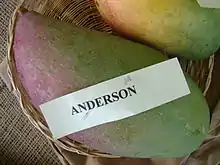| Mangifera 'Anderson' | |
|---|---|
 The display of Anderson mango at the Redland Summer Fruit Festival, Fruit and Spice Park, Homestead, Florida. | |
| Genus | Mangifera |
| Species | Mangifera indica |
| Hybrid parentage | 'Sandersha' × 'Haden' |
| Cultivar | 'Anderson' |
| Origin | Miami, Florida, USA |
The 'Anderson' mango is a named mango cultivar that originated in south Florida.
History
The original tree was started from a 'Sandersha' mango seed sent from Jamaica in 1926 and was planted on the L. F Anderson's property in Miami, Florida. The tree fruited in 1931 and was named in 1948. A 2005 pedigree analysis estimated that 'Anderson' was a cross between the 'Sandersha' and 'Haden' cultivars.[1] Anderson did not become a popular commercial variety due to the fruit's tendency to split while still on the tree. Its dooryard adaptation was limited as well, though it has been used to make chutneys.
'Anderson' trees are planted in the collections of the University of Florida's Tropical Research and Education Center in Homestead, Florida[2] as well as the Miami-Dade Fruit and Spice Park,[3] also in Homestead.
Description
The fruit is large in size, averaging over one pound in weight. Its shape is similar to 'Sandersha', being long and slender, containing a small lateral beak. The skin is thick and has a green to yellow color with some crimson blush. The flesh is yellow, acidulous and mild in flavor, without fiber and containing a monoembryonic seed. It ripens from July to August in Florida.[4]
The tree is a vigorous grower with a large, semi-open canopy.
References
- ↑ Cecile T. Olano; Raymond J. Schnell; Wilber E. Quintanilla; Richard J. Campbell (2005). "Pedigree analysis of Florida mango cultivars" (PDF) (118). Proc. Fla. State Hort. Soc: 192–197. Archived from the original (PDF) on 2010-06-18. Retrieved 2010-05-08.
{{cite journal}}: Cite journal requires|journal=(help) - ↑ http://trec.ifas.ufl.edu/crane/pdfs/TREC-Fruit-Collections.pdf Archived 2018-04-08 at the Wayback Machine Page 2, #4
- ↑ "Friends of the Fruit & Spice Park - Plant and Tree List 2008". Archived from the original on 2010-07-11. Retrieved 2010-11-14.
- ↑ Campbell, Richard J. (1992). A Guide to Mangos in Florida. Fairchild Tropical Garden. p. 31. ISBN 0-9632264-0-1.